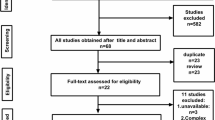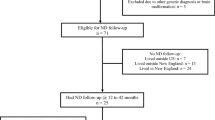Abstract
Purpose
Reporting neurodevelopmental outcome of 8-year-old children treated with neonatal extracorporeal membrane oxygenation (ECMO).
Methods
In a follow-up study in 135 8-year-old children who received neonatal ECMO between 1996 and 2001 we assessed intelligence (Revised Amsterdam Intelligence Test), concentration (Bourdon-Vos test), eye-hand coordination (Developmental Test of Visual-Motor Integration) and behavior (Child Behavior Checklist and Teacher Report Form).
Results
Intelligence fell within normal range (mean IQ 99.9, SD 17.7, n = 125) with 91 % of the children following regular education. Significantly more children attended special education (9 %) or received extra support in regular education (39 %) compared with normative data. Slower working speed (χ2 = 132.36, p < 0.001) and less accuracy (χ2 = 12.90, p < 0.001) were found on the Bourdon-Vos test (n = 123) compared with normative data. Eye-hand coordination fell within the normal range (mean 97.6, SD 14.3, n = 126); children with congenital diaphragmatic hernia scored lowest but still normally (mean 91.0, SD 16.4, n = 28). Mothers (n = 117) indicated more somatic and attention behavior problems; teachers (n = 115) indicated more somatic, social, thought, aggression and total problems compared with normative data. Mothers indicated more somatic problems than teachers (p = 0.003); teachers reported more attention problems than mothers (p = 0.036; n = 111).
Conclusions
Eight-year-old children treated with neonatal ECMO fall in the normal range of intelligence with problems with concentration and behavior. Long-term follow-up for children treated with neonatal ECMO should focus on early detection of (subtle) learning deficits.



Similar content being viewed by others
References
UK Collaborative Trial Group (1996) UK collaborative randomised trial of neonatal extracorporeal membrane oxygenation. Lancet 348:75–82
Schaible T, Hermle D, Loersch F, Demirakca S, Reinshagen K, Varnholt V (2010) A 20-year experience on neonatal extracorporeal membrane oxygenation in a referral center. Intensive Care Med 36:1229–1234
Extracorporeal life support organization: ECLS registry report international summary. Ann Harbor, MI, 2013
Mugford M, Elbourne D, Field D (2010) Extracorporeal membrane oxygenation for severe respiratory failure in newborn infants (review). Evid-Based Child Health 5:241–298
Bennett CC, Johnson A, Field DJ, Elbourne D (2001) UK collaborative randomised trial of neonatal extracorporeal membrane oxygenation: follow-up to age 4 years. Lancet 357:1094–1096
UK Collaborative Trial Group (1998) The collaborative UK ECMO trial: follow-up to 1-year of age. Pediatrics 101:E1
McNally H, Bennett CC, Elbourne D, Field DJ, UK Collaborative Trial Group (2006) United kingdom collaborative randomized trial of neonatal extracorporeal membrane oxygenation: follow-up to age 7 years. Pediatrics 117:e845–e854
Liem KD, Hopman JC, Oeseburg B, de Haan AF, Festen C, Kollee LA (1995) Cerebral oxygenation and hemodynamics during induction of extracorporeal membrane oxygenation as investigated by near infrared spectrophotometry. Pediatrics 95:555–561
Hofkosh D, Feldman HM, Thompson AE, Nozza RJ, Kemp SS, Bowen AD (1991) 10 years of extracorporeal membrane oxygenation: neurodevelopmental outcome. Pediatrics 87:549–555
Rollins MD, Yoder BA, Moore KR, Barnhart DC, Jones C, Null DM et al (2012) Utility of neuroradiographic imaging in predicting outcomes after neonatal extracorporeal membrane oxygenation. J Pediatr Surg 47:76–80
Hanekamp MN, Mazer P, van der Cammen-van Zijp MH, van Kessel-Feddema BJ, Nijhuis-van der Sanden MW, Knuijt S et al (2006) Follow-up of newborns treated with extracorporeal membrane oxygenation: a nationwide evaluation at 5 years of age. Crit Care 10:R127
Kumar P, Shankaran S, Bedard MP, Delaney-Black V (1999) Identifying at risk infants following neonatal extracorporeal membrane oxygenation. J Perinatol 19:367–372
Nijhuis-van der Sanden MW, van der Cammen-van Zijp MH, Janssen AJ, Reuser JJ, Mazer P, van Heijst AF et al (2009) Motor performance in 5-year-old extracorporeal membrane oxygenation survivors: a population-based study. Crit Care 13:R47
Glass P, Wagner AE, Papero PH, Rajasingham SR, Civitello LA, Kjaer MS et al (1995) Neurodevelopmental status at age 5 years of neonates treated with extracorporeal membrane oxygenation. J Pediatr 127:447–457
Rais-Bahrami K, Wagner AE, Coffman C, Glass P, Short BL (2000) Neurodevelopmental outcome in ECMO vs near-miss ECMO patients at 5 years of age. Clin Pediatr (Phila) 39:145–152
Iklé L, Iklé DN, Moreland SG, Fashaw LM, Rosenberg AR (1999) Survivors of neonatal extracorporeal membrane oxygenation at school age: unusual findings on intelligence testing. Dev Med Child Neurol 41:307–310
Stolar CJ, Snedecor SM, Bartlett RH (1991) Extracorporeal membrane oxygenation and neonatal respiratory failure: experience from the extracorporeal life support organization. J Pediatr Surg 26:563–571
Hofhuis W, Hanekamp MN, Ijsselstijn H, Nieuwhof EM, Hop WC, Tibboel D et al (2011) Prospective longitudinal evaluation of lung function during the first year of life after extracorporeal membrane oxygenation. Pediatr Crit Care Med 12:159–164
Duncan O (1961) A socioeconomic index for all occupations. In: Reiss AJ Jr, Hatt PK, Nort CC (eds) Occupations and social status. Free Press, New York, pp 109–138
Bleichrodt N, Drenth PJD, Zaal JM, Resing WCM (1984) Revisie amsterdamse kinder intelligentie test: instructies, normen, psychometrische gegevens. Swets and Zeitlinger, Lisse
Smits-Engelsman B, Hill EL (2012) The relationship between motor coordination and intelligence across the IQ range. Pediatrics 130:e950–e956
Vos P (1992) Bourdon-Vos: handleiding. Swets and Zeitlinger, Lisse
Beery KE, Beery NA (2004) Beery VMI: administration, scoring, and teaching manual. NCS Pearson inc., Minneapolis
Verhulst FC, van der Ende J, Koot HM (1996) Child behaviour checklist (CBCL)/4–18: dutch manual. Afdeling Kinder-en Jeugdpsychiatrie, Sophia Kinderziekenhuis/Academisch Ziekenhuis Rotterdam/Erasmus Universiteit Rotterdam, Rotterdam
Verhulst FC, van der Ende J, Koot HM (1997) Teacher’s report form (TRF): dutch manual. Afdeling Kinder-en Jeugdpsychiatrie, Sophia Kinderziekenhuis/Academisch Ziekenhuis Rotterdam/Erasmus Universiteit Rotterdam, Rotterdam
Tick NT, Van Der Ende J, Verhulst FC (2007) Twenty-year trends in emotional and behavioral problems in dutch children in a changing society. Acta Psychiatr Scand 116:473–482
The Dutch Inspectorate of Education (2011) The state of education in the Netherlands: education report 2009/2010. Education Inspectorate, Mininstry of Education, Culture and Science, Utrecht
Apperloo J, Van der Bie R (eds) (2011) Jaarboek onderwijs in cijfers. Statistics Netherlands, Den Haag/Heerlen
Jobe AH, Bancalari E (2001) Bronchopulmonary dysplasia. Am J Respir Criti Care Med 163:1723–1729
Allison P (1999) Logistic regression using the SAS system: theory and application. SAS Institute, New York
Goodman M, Gringlas M, Baumgart S, Stanley C, Desai SA, Turner M et al (2001) Neonatal electroencephalogram does not predict cognitive and academic achievement scores at early school age in survivors of neonatal extracorporeal membrane oxygenation. J Child Neurol 16:745–750
Madderom MJ, Gischler SJ, Duivenvoorden H, Tibboel D, IJsselstijn H (2013) Follow-up of children treated with extracorporeal membrane oxygenation: impaired health at 5 years of age. Pediatr Crit Care Med 14:183–193
Antonelli M, Bonten M, Chastre J, Citerio G, Conti G, Curtis JR et al (2012) Year in review in Intensive Care Medicine 2011: ARDS and ECMO, weaning, mechanical ventilation, noninvasive ventilation, pediatrics and miscellanea. Intensive Care Med 38:542–556
Verhulst FC, Akkerhuis GW (1989) Agreement between parents and teachers ratings of behavioral/emotional problems of children aged 4–12. J Child Psychol Psychiatry 30:123–136
Peetsold MG, Huisman J, Hofman VE, Heij HA, Raat H, Gemke RJ (2009) Psychological outcome and quality of life in children born with congenital diaphragmatic hernia. Arch Dis Child 94:834–840
Schumacher RE, Palmer TW, Roloff DW, LaClaire PA, Bartlett RH (1991) Follow-up of infants treated with extracorporeal membrane oxygenation for newborn respiratory failure. Pediatrics 87:451–457
Madderom MJ, Toussaint L, van der Cammen-van Zijp MH, Gischler SJ, Wijnen RMH, Tibboel D et al (2012) Congenital diaphragmatic hernia with (out) ECMO: impaired development at 8 years. Arch Dis Child Fetal Neonatal Ed. doi:10.1136/archdischild-2012-303020
Bulas D, Glass P (2005) Neonatal ECMO: neuroimaging and neurodevelopmental outcome. Semin Perinatol 29:58–65
Graaf Jd, van Lingen RA, Valkenburg AJ, Weisglas-Kuperus N, Jebbink LG, Wijnberg-Williams B et al (2013) Does neonatal morphine use affect neuropsychological outcomes at 8–9 years of age? Pain 154:449–458
Acknowledgments
This article was written on behalf of the Dutch national ECMO follow-up team, consisting of pediatricians, developmental psychologists, speech-language pathologists and pediatric physiotherapists in both centers. The authors thank the entire team and specifically the ones not mentioned in the author list: Marjolein Spoel (physician), Monique van der Cammen- van Zijp (physiotherapist), Anne Zirar-Vroegindeweij and Annabel van Gils-Frijters (developmental psychologists) from Erasmus MC- Sophia Children’s Hospital and Anjo Janssen (physiotherapist) and Sandra de Groot (speech-language pathologist) from Radboud University Nijmegen Medical Center for their contribution to this study. Ko Hagoort provided editorial advice. Financial support was provided by the Swart-van Essen Fund.
Conflicts of interest
On behalf of all authors, the corresponding author states that there is no conflict of interest.
Author information
Authors and Affiliations
Corresponding author
Additional information
On behalf of the Dutch ECMO follow-up team.
Electronic supplementary material
Below is the link to the electronic supplementary material.
Rights and permissions
About this article
Cite this article
Madderom, M.J., Reuser, J.J.C.M., Utens, E.M.W.J. et al. Neurodevelopmental, educational and behavioral outcome at 8 years after neonatal ECMO: a nationwide multicenter study. Intensive Care Med 39, 1584–1593 (2013). https://doi.org/10.1007/s00134-013-2973-1
Received:
Accepted:
Published:
Issue Date:
DOI: https://doi.org/10.1007/s00134-013-2973-1




